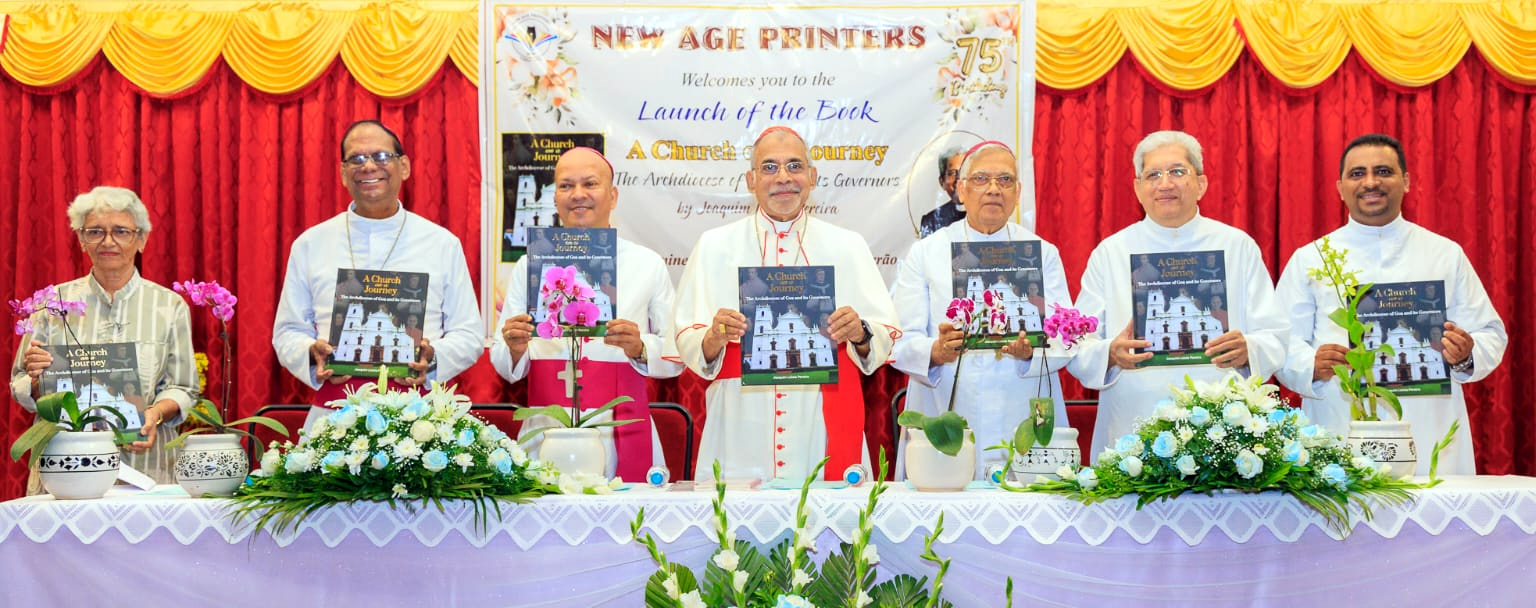
PANAJI
An archbishop who dined with 12 homeless people each day for 15 years of his reign and another archbishop who insisted on European missionaries learning Konkani within 6 months of their arrival in Goa are some of the fascinating details which have emerged in a new and unique book on the governors of the Archdiocese of Goa.
Archbishop of Goa Cardinal Filipe Neri Ferrão on Monday released the book ‘A Church on a Journey: The Archdiocese of Goa and its Governors’, authored by Fr Joaquim Loiola Pereira, at the St Joseph Vaz Spiritual Renewal Centre, Old Goa.
The launch coincided with the 75th birthday of Fr Pereira, who serves as secretary to the archbishop.
The event was attended by Auxiliary Bishop of Goa and Daman Simião Fernandes, Bishop Emeritus of Port Blair Alex Dias SFX, Bishop Emeritus of Sindhudurg Alwyn Barretto, and Prof. Isabel de Santa Rita Vás.
Published by New Age Printers of the Archdiocese of Goa and Daman, the book traces five centuries of the archdiocese’s history through the lives and ministries of its bishops and priests.
Introducing the book, Prof. Isabel de Santa Rita Vás described it as “a work of great love and care” and “an essential contribution to the study of the Church in Goa.”
She highlighted that Fr Pereira, with nearly five decades in priestly ministry and over 30 years at the Bishop’s House, brought first-hand knowledge, historical insight, and linguistic skills to the volume.
She added that the book is the first in English to feature all the governors of the Church in Goa—bishops and priests—and will appeal to both students of Church history and Goans in general.
She called it “a remarkable contribution to understanding the Church’s faith, challenges, and enduring spirit in Goa.”
Fr Pereira explained that the book was inspired by the 35 portraits of archdiocesan governors in the Throne Hall at the Archbishop’s House.
“Over time, they seemed to plead, ‘Take us into the world; let people know who we were.’ After years of their silent appeal, I finally responded—and this book is the result,” he said.
Sharing select anecdotes, Fr Pereira highlighted the visionary and compassionate deeds of past archbishops, such as dining daily with the homeless, and requiring missionaries to learn Konkani.
He said one 16th-century archbishop had even encouraged lay people to approach the church council with their complaints against church authorities, including himself, while assuring them of a fair and impartial hearing.
Fr Pereira also acknowledged the Church’s complex history, including colonial influence and cultural imposition, but emphasised that the book portrays its full spectrum—faith, struggles, and evolution.
Expressing satisfaction, Fr Pereira concluded, “I am immensely glad I finally did it. Those 35 distinguished figures can now step down from the wall and meet readers and admirers. Their stories deserve to be known.”
Dr Isabel Mendonca Raimundo, Consul General of Portugal in Goa, and her husband, Dr Luis Pereira Coutinho, were present on the occasion.
Fr Myron Barreto, manager of New Age Printers, welcomed the gathering. The event, which also featured Marian hymns by Omar de Loiola Pereira and his choir, was anchored by Fr Ramiro Luis and concluded with a vote of thanks by Fr Onasis D’Cruz.
__________________________________________________________
Archbishop of Goa Cardinal Filipe Neri Ferrão has stated that each bishop who served the archdiocese of Goa left a unique imprint, whether as builders, reformers, or visionaries, thereby demonstrating continuity and change in the archdiocese.
In his address after releasing the book ‘A Church on a Journey: The Archdiocese of Goa and its Governors’, Cardinal Ferrão emphasised that the book goes beyond dates and facts to capture “the spirit of the times and the character of the bishops who shepherded the faithful through peace, growth, and transformation.”
Cardinal Ferrão described the book as “a labour of love” and “a narrative of faith, leadership, and community that has journeyed for over five centuries.”
He praised Fr Pereira for his “discretion, grace, and quiet faithfulness” over three decades, calling him a “meticulous chronicler and lover of history.”